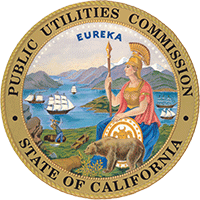Area Codes and Numbering
The North American Numbering Plan (NANP) is the telephone numbering system within which the Public Switched Telephone Network is managed in the United States, Canada, and some Caribbean countries by the North American Numbering Plan Administrator (NANPA). The NANP is divided into smaller Numbering Plan Areas that are each identified by a three-digit code, commonly known as an area code. Telephone numbers in the NANP are structured in the format NPA-NXX-XXXX, in which
NPA is the 3-digit area code that identifies a specific geographic area;
NXX is the 3-digit prefix that identifies a specific central office within an area code; and
XXXX is the 4-digit line number that identifies a specific line within a central office.
The Federal Communications Commission (FCC) has exclusive jurisdiction over telephone numbering in the United States but has delegated specific authority to state regulatory agencies. Tasked with the authority granted by the FCC, the CPUC conducts area code relief and enforces number conservation in California in accordance with Public Utilities Code Section 7930-7943.
California currently has 40 area codes. A new area code is added to a geographic area when there are no more three-digit prefixes available in the existing area code. Area codes are added in the form of a geographic split or an overlay. California has added fourteen area codes using the overlay method since 2006.
California Area Codes
| 209/350* |
530/837* |
661 |
831 |
| 213/323/738* |
559/357* | 707/369* | 909/840* |
| 310/424* | 562 | 714/657* | 916/279* |
| 408/669* | 619/858* | 760/442* | 925 |
| 415/628* | 626 | 805/820* | 949 |
| 510/341* | 650 | 818/747* | 951 |
N11 Codes
211 - Community information and referral services. 211 service is provided by local community-based or government organizations that are authorized by the CPUC to use the 211 code to provide information and referrals to health and human services.
311 - Non-emergency governmental services. 311 service is administered by municipal governments.
411 - Local Directory Assistance. 411 directory assistance is provided by individual telecommunications service providers or independent providers.
511 - Traffic and Transportation information. The California Highway Patrol, California Department of Transportation, and local transportation agencies oversee 511 operations.
611 - General Customer Service. 611 service is provided by individual telecommunications service providers.
711 - Telecommunications Relay Service for the speech and hearing impaired. In California, 711 Relay service is provided through Hamilton Relay.
811 - Call-before-you-dig phone number for access to location of buried utilities. Underground Service Alert, a nonprofit organization, manages 811 calls and operates two call centers: USA North 811 for northern California and Dig Alert for southern California.
911 - Emergency services. The California Office of Emergency Services and local public safety agencies oversee 911 emergency service operations.
988 - National Suicide Prevention Lifeline. The United States Department of Health and Human Services' Substance Abuse and Mental Health Services Administration, in partnership with the Department of Veterans Affairs, administers the National Suicide Prevention Lifeline, which is a national network of approximately 170 local and state funded crisis centers.
Information for Consumers
9-8-8 Dialing Code
On July 16, 2020, the FCC designated 988 as the 3-digit code for the National Suicide Prevention Lifeline (FCC 20-100), and ordered all area codes that have the 988 prefix in use and 7-digit dialing to change to 1+10-digit dialing to avoid problems routing calls dialed with the 9-8-8 3-digit code. In California, the 209, 530, 562, 626, 650, 707, 925, 949, and 951 area codes are impacted by this FCC order.
559/357 Area Code
The 559 area code is expected to run out of available prefixes by September 2025. On December 14, 2023, the CPUC approved an overlay and a new area code in Decision 23-12-012 to provide additional numbering resources in the geographic region served by the 559 area code. The new area code to overlay the 559 area code is the 357 area code.
530/837 Area Code
The 530 area code is running out of available prefixes, and it's expected to be exhausted by September 2025. To address this, on June 8, 2023, the CPUC approved an overlay plan, as outlined in Decision 23-06-007, which involves introducing a new area code, 837, to supplement the existing 530 area code.
213/323/738 Area Code
The 213/323 area code is projected to be depleted of available prefixes by June 2025. On March 16, 2023, the CPUC approved an overlay and a new area code in Decision 23-03-006 to provide additional numbering resources in the geographic region served by the 213/323 area codes. The new area code to overlay the 213/323 area code is the 738 area code.
209/350 Area Code
On November 28, 2022, the 350 area code was put in service and was overlaid onto the existing 209 area code.
707/369 Area Code
On February 1, 2023, the new 369 area code was put in service and was overlaid onto the existing 707 area code.
Information for Carriers
- Interconnected voice over internet providers obtaining numbering resources in California must collect and remit surcharges in support of California universal service programs
Contact
For inquiries related to numbering policy and area code relief, please direct your questions to staff at Numbering_Help@cpuc.ca.gov
